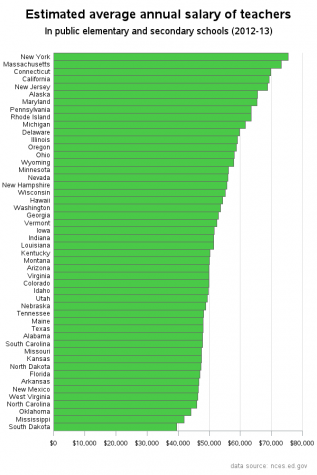Compensation for Education
A teacher at Lake Ridge High School lectures her class, asking them to go onto Canvas to work on an assignment.
It’s 2:55 PM, and the bell rings throughout the school. Students rush out the front door, ready to begin their after-school activities. Teachers begin to pack up their things and straighten up their classrooms. They put pencils back in their drawers, paper into stacks, and do some last-minute grading. However, according to an analysis of federal data by Education Week, a magazine dedicated to educators across America, one in five of these teachers will rush off to a second job – being a part-time tutor, working at a retail store, or even as a teacher in another district – just trying to afford food for their families, pay bills and taxes, and keep a roof over their head in a rising housing market.
In the 2018-2019 school year, Texas teacher salaries can start as low as $28,080, according to the Texas Education Agency website. In comparison, the salary of a McDonalds store manager can start as low as $31,000 based on data collected from Glassdoor, a site dedicated to job searching. Texas ranks 27th in the US according to the National Education Association in terms of average teacher salaries. The Lone Star State still maintains its low ranking, despite Governor Greg Abbott saying he wants to give top teachers six-figure salaries.
At Mansfield ISD, the average salary for teachers is $53,652 – 2% above the national average, but educators like AP US History teacher Thomas White, continue to feel their efforts go unappreciated by lawmakers. White claims that, despite his district’s higher-than-average salary, he still doesn’t get compensated for the over one thousand dollars he pays from his own salary annually for additional supplies for his classroom and students.
“We get provided basic things like dry erase markers, paper, and colored pencils, but teachers usually end up spending large amounts of our own money to keep our classrooms up to expectations and to provide for students. I usually spend $1000-$1500 every year out-of-pocket, and that amount usually isn’t compensated by the district. We used to be able to write off some of the additional school supplies, but recently the amount that we could write off was decreased significantly,” said White.
White is not the only one who feels that he isn’t compensated fairly, according to Chelsea Baldwin, Deputy Executive Director at the United Educators Association of Texas. Baldwin claims that many complaints come in throughout the year about how the increase of insurance prices are barely being reflected in their average annual raise, and how teachers are bringing back less money to their families every year.
“Even with raises, the employees are taking home less pay due to the increases in medical insurance premiums. The total annual raise in Mansfield ISD was $625 for teachers with a bachelor’s degree. The annual insurance increase for employees that cover their family was between $696 – $2280 depending on the TRS [Teacher Retirement System of Texas] plan,” said Baldwin.

The UEA, according to Baldwin, is a strong component in sparking the conversation about how much teachers should be paid throughout the Dallas-Fort Worth area. Working as an ambassador between the teachers they represent and the districts, the UEA continually pushes raises and bonuses for employees of districts around Texas.
” [Teacher salaries are] based on the market rate of teacher salaries in the state and nearby districts. MISD’s overall budgetary needs are considered when determining all pay grades and ranges, including that of teachers. One of the district’s goals is to remain within Top Five teacher salaries in the Western Metroplex area,” said Cantu.
Even though no party has taken a definite side on teacher salaries, this is still a highly politicized issue. With the recent election, candidates across the country appealed to educators in an attempt to gain their vote. Only time will tell if these politicians keep their promise to teachers and school districts, by directing funds towards education. But, for now, teachers will have to continue to persevere through their adversity, to the light at the end of the tunnel.
https://www.youtube.com/watch?v=LpfNPMX1KVc



